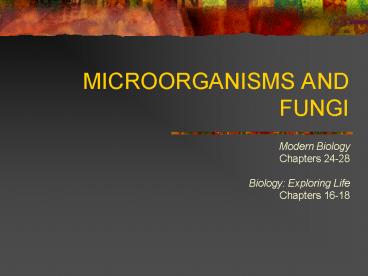MICROORGANISMS AND FUNGI - PowerPoint PPT Presentation
1 / 30
Title:
MICROORGANISMS AND FUNGI
Description:
Autotrophic or heterotrophic. Autotrophic (self-feeding) ... Multicellular autotrophic protists. Red algae. Brown algae (kelp) Green algae (seaweed) ... – PowerPoint PPT presentation
Number of Views:80
Avg rating:3.0/5.0
Title: MICROORGANISMS AND FUNGI
1
MICROORGANISMS AND FUNGI
- Modern Biology
- Chapters 24-28
- Biology Exploring Life
- Chapters 16-18
2
Viruses
- Nonliving particlesabsence of
- Cellular organization
- Viruses have no cell membranes or cytoplasm.
- Growth
- Homeostasis
- Metabolism
- Reproduction
- Viruses are obligate intracellular parasites.
3
Viral Structure and Shape
- Nucleic acid (DNA or RNA) surrounded by a protein
coat called a capsid - Sometimes a lipid envelope with glycoprotein
projections outside the capsid - Taken from host cell membrane during viral
replication - Used for attachment to, and infection of, a host
cell - Icosahedral or helical
4
Classification of Viruses
- Adenoviruses
- DNA, icosahedral, non-enveloped
- Ex. Common cold
- Herpesviruses
- DNA, icosahedral, enveloped
- Ex. Herpes simplex, chickenpox
- Helical enveloped RNA viruses
- Ex. Influenza, rabies, measles, TMV (tobacco
mosaic virus)
5
Classification of Viruses (continued)
- Retroviruses
- RNA, icosahedral, enveloped
- Reverse transcription
- Ex. HIV (human immunodeficiency virus)
- ViroidsNOT viruses
- RNA with no capsid
- PrionsNOT viruses
- Abnormal, clumping proteins with no associated
nucleic acid - Ex. Scrapie, mad cow disease
6
Lytic Cycle
- Virulent viruses
- Attachment
- Entry
- Replication
- Assembly
- Release
7
Lysogenic Cycle
- Temperate viruses
- Attachment
- Injection
- Integration (prophage or provirus)
- Cell multiplication
- Certain stimuli eventually trigger virulence.
8
Impact of Viruses
- Controlling viral diseases
- Antibioticsno!
- Vaccination
- Antiviral drugs enzyme inhibitors
- Ex. Acyclovir, AZT, protease inhibitors
- Genetic engineering
9
Kingdoms Archaebacteria and Eubacteria
- (Domains Archaea and Bacteria)
10
Cellular Organization
- Prokaryotic
- Polysaccharide cell wall
- Unicellular
- Three shapes
- Coccus
- Bacillus
- Spirillum
11
Cellular Organization (continued)
- Unicellular (continued)
- Often found in colonies
- Strepto-
- Staphylo-
12
Metabolism
- Food/energy source
- Autotrophic or heterotrophic
- Autotrophic (self-feeding)
- Photosynthetic (sunlight)
- Chemosynthetic (inorganic molecules)
- Heterotrophic (other-feeding)
- Parasitic (living organisms)
- Saprophytic (dead organisms)
13
Metabolism (continued)
- Digestion / energy release
- Cellular respiration (aerobicwith oxygen) and/or
fermentation (anaerobicwithout oxygen) - Facultative anaerobes can do either.
- By-products of fermentation
- Alcohol (ethanol)
- Lactic acid
14
Homeostasis
- Taxis
- Directional movement toward or away from various
stimuli - Endospore
- State of dormancy through which bacteria survive
unfavorable conditions
15
Reproduction
- Asexualbinary fission
- Rapid
- Generation time 12-20 minutes
- Natural selection acts quickly to cause evolution
in bacterial populations.
16
Heredity
- Bacteria in colonies are genetically identical
offspring of one original cell. - Plasmids
- Extra circles of DNA that carry certain bacterial
genes - May be exchanged between bacteria through
appendages called pili (singular, pilus)
17
Archaebacteria
- Ancient bacteria
- Most likely ancestors of eukaryotic cells
- Harsh habitats
- Oxygen-poor swamps and marshes
- Extremely salty water
- Hot sulfur springs
18
Eubacteria
- True bacteria
- Normal habitats (especially warm, moist places)
- IntestinesE. coli bacteria help digest food.
- Underarmsbacterial waste products contribute to
body odor. - Respiratory systemsinus infections, strep
throat, etc. - May be beneficial or harmful
19
Kingdom Protista
- (Domain Eukarya)
20
Cellular Organization
- Eukaryotic
- Endosymbiotic theory Protists evolved from
mutualistic associations of smaller bacteria
living inside larger bacteria. - Unicellularexcept algae
21
Metabolism
- Autotrophic or heterotrophic
- Unicellular autotrophic (plant-like) protists
- Phytoplankton
- Base of aquatic food chains
- Diatoms
- Silica shells ground for grit in toothpaste
- Dinoflagellates
- Red tides
22
Metabolism (continued)
- Multicellular autotrophic protists
- Red algae
- Brown algae (kelp)
- Green algae (seaweed)
23
Metabolism (continued)
- Heterotrophic (animal-like) protists
- Amoebae
- Plasmodium causes malaria.
- Protozoans
- Paramecium
- Giardia causes giardiasis.
24
Homeostasis
- Movement
- Cilia
- Flagella
- Pseudopods
25
Reproduction and Heredity
- Mitosis and/or meiosis
- Mitosisasexual
- Offspring are genetically identical to parent.
- Meiosisconjugation
- Two haploid protists join and recombine their
DNA. - Offspring exhibit genetic variation.
26
Kingdom Fungi
- (Domain Eukarya)
27
Cellular Organization
- Hyphae (singular hypha)
- Name given to the cells of fungi
- Eukaryotic
- Some hyphae are multinucleate.
- Multicellularexcept yeasts
28
Anatomy
- Two main body parts
- Mycelium
- Branched network of hyphae that extend and spread
out into the substrate (food source) where a
fungus is living - Fruiting body
- Structure above the surface of the substrate
where meiosis occurs to produce spores for sexual
reproduction
29
Metabolism and Homeostasis
- Heterotrophic
- Absorption (absorptive nutrition)
- Hyphae in the mycelium secrete digestive enzymes
into the substrate. - Hyphae then absorb the liquefied food.
- Sessile
- Fungi are stationarypermanently attached to
their substrate. - Most growth occurs at the tips of hyphae in order
to obtain more nutrients. - Environmental conditions determine whether fungi
will reproduce sexually or asexually.
30
Reproduction and Heredity
- Asexual and/or sexual
- Asexualmitosis
- Production of genetically identical hyphae
- Sexualmeiosis
- Production of spores that are dispersed by wind
or water - Classification based on type of spore producedin
other words, mode of sexual reproduction































